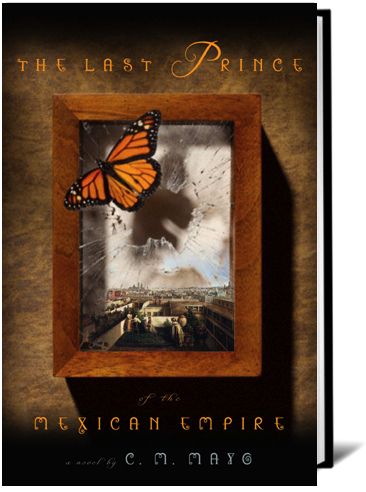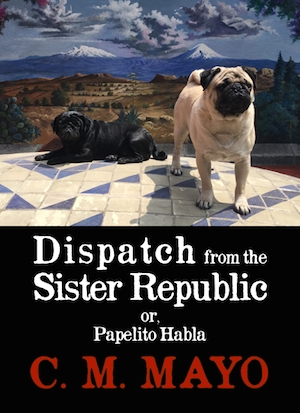
ON SEEING AS AN ARTIST OR,
FIVE TECHNIQUES FOR A JOURNEY TO EINFÜHLUNG
Transcript
of Remarks for the Panel on
"Writing Across Borders and Cultures"
Women
Writing the West Conference
Santa Fe, New Mexico, October 15, 2016
C.M. MAYO |
See the handout:
"A Reading
List for Writing Across Borders and Cultures" |
 How many of you have been
to Mexico?
Well, viva Mexico! Here we are in New Mexico, Nuevo México.
On this panel, with Dawn Wink and Kathryn Ferguson, it seems
we are all about Mexico. I write both fiction and nonfiction,
most of it about Mexico because that is where I have been living
for most of my adult life— that is, the past 30 years—
married to a Mexican and living in Mexico City. How many of you have been
to Mexico?
Well, viva Mexico! Here we are in New Mexico, Nuevo México.
On this panel, with Dawn Wink and Kathryn Ferguson, it seems
we are all about Mexico. I write both fiction and nonfiction,
most of it about Mexico because that is where I have been living
for most of my adult life— that is, the past 30 years—
married to a Mexican and living in Mexico City.
But in this talk
I would like to put on my sombrero, as it were, as an historical
novelist, and although my novel, The Last Prince
of the Mexican Empire,
is about Mexico, I don’t want to talk so much about Mexico
as I do five simple, powerful techniques that have helped me,
and that I hope will help you to see as an artist and write across
borders.
I start with
the premise that truth is beauty and beauty is truth, and that
seeing clearly, seeing as an artist, is what brings us towards
truth.
My second premise
is that through narrative we become more human—and that
sure beats the alternative.
My third premise
is that writing about anyone else, anywhere, is to some degree
writing across a border. The past is a border. Religion is a
border. Gender is a border. Social class is a border. Language.
Physical conditions— people who have peanut allergies are
different than people who do not have peanut  allergies. allergies.
THE CHALLENGE
The challenge
is this: As Walter Lippman put it, “For the most part we
do not first see and then define, we define first and then see.”
And I would agree with Lippman that in our culture, for the most
part, and of course, with oodles of exceptions, we are not educated
to see, then define. Ironically, the more educated we are, the
more we as literary artists may have something to overcome in
this respect.
The poet e.e.
cummings put it this way: “An artist is no other than he
who unlearns what he has learned, in order to know himself.”
 Betty Edwards, the artist
who wrote Drawing
on the Right Side of the Brain, calls seeing as an artist “a different,
more direct kind of seeing. The brain’s editing is somehow
put on hold, thereby permitting one to see more fully and perhaps
more realistically.” Betty Edwards, the artist
who wrote Drawing
on the Right Side of the Brain, calls seeing as an artist “a different,
more direct kind of seeing. The brain’s editing is somehow
put on hold, thereby permitting one to see more fully and perhaps
more realistically.”
How many of you
are familar with Drawing on the Right Side of the Brain?
How many of you
have tried that exercise where you take a black and white photograph
of a face, turn it upside down, and copy it?
 Turning
the picture upside down tricks your brain to get past the labels
of that is a nose, or, say, that is an eyelid, a wrinkle, a cheek...
You are just drawing what you actually see, this weird jumble
of shapes and shadows. Turning
the picture upside down tricks your brain to get past the labels
of that is a nose, or, say, that is an eyelid, a wrinkle, a cheek...
You are just drawing what you actually see, this weird jumble
of shapes and shadows.
You turn it right side side up and, wow... it’s Albert Einstein!
And why is seeing
this way, seeing as an artist so important? Because if we as
writers cannot see as artists, with that wide open, innocent
sense of attention and wonder that would see first, and
then, maybe, define, whether we are writing about a Mexican
or a Korean ballet dancer or a Texas cowboy or the old lady who
died in the house next door one hundred years ago— whomever
we are writing about, if we cannot see that human being with
the eyes of an artist, our writing about them will not be fresh,
it will be fuzzy, blunt, stale, peculiarly distorted. In a word:
stereotypical.
It will be distorted
in the same way that people who do not know how to draw will
make the eyes too big, the foreheads too small, and ignore most
of the shadows—the face they draw looks like a cartoon,
not the way the face actually looks, because the left side of
their brain was busy labeling things.
Seeing as an
artist, on the other hand, is seeing without filters. Radical
seeing. For us as writers this means seeing without prejudice,
without bias, without the... shall we say, enduring presumptions.
It is, to quote
the artist Betty Edwards again, “an altered state of awareness.”
And “This shift to an altered state enables you to see well.”
So how do we
get to that altered state? And then see?
FIVE TECHNIQUES
FOR RADICAL SEEING
Technique
#1
It starts
with slowing down, being here now, in your body. Breathe in and
breathe out, slowly, keeping your attention on following each
breath, in and out. In and out. Five to 10 of these usually works
just fine. If you’re really stressed out and distracted,
maybe more. Whatever works for you.
Technique
#2
Set asides.
This quiets the so-called “monkey mind.” Using a pen
and paper, and using the present tense—using the present
tense is key—simply writing down what you want to set aside
for the duration of your writing session.
I write:
|
I SET ASIDE:
The phone might ring.
I am concerned that the front tire of my car looks low.
I am worried that so and so will say thus and such... whatever.
|
You just set these aside. And
because you are writing them down, no worries, they will be there
for you when you need to pick them up again.
Really, it is that simple. And
incredibly powerful.
Now to actually seeing as an
artist. I think of it as adopting the mindset of a four year
old child. A four year old is old enough to speak and maybe even
read and write a little bit, but young enough to have no presumption,
no bias, no definitions, no worry about time, no social status
to defend. No need to be “cool.” It’s just, you’re
four and you’re noticing things, playfully. Innocently.
Dangerously. Like that little boy who asked, Why isn’t
the emperor wearing any clothes?
So we can start noticing things.
Like, ooooh, the person sitting next to us. What is the shape
of her hair? What’s on her left hand? If you could touch
her sleeve what would it probably feel like?
Other people may inform us that
a wall is, say, pink. But if we can see as an artist, get past
all the filters, we will see that the wall is cotton candy pink,
over there. Down in the corner, away from the window, it might
be more of an ash rose. Over there, where it catches the glow
from the reflection, it’s a salmon pink. Up near the ceiling
light, almost white. It’s gray, it’s lavender. That
wall might have hundreds of different colors.
As Matthew B. Crawford writes
in The
World Beyond Your Head:
|
“The uniformity of the wall’s
color is a social fact, and what I perceive, in every
day life, seems to be such social facts, rather than the facts
of optics... To perceive the wall as variously colored, I have
to suspend my normal socially informed mode of perception. This
is what an artist does.”
|
Other people may inform us about
other people, such as, say, Mexicans. Mexicans are like this
or, Mexicans are like that. But if we can see as an artist, we
may see something, someone who does not fit into, shall we say,
the enduring presumptions. Such as Maximilian von Habsburg.
 Speaking
of emperors, Maximilian wore some very nice clothes. Beautifully
tailored suits and uniforms. Speaking
of emperors, Maximilian wore some very nice clothes. Beautifully
tailored suits and uniforms.
Who has heard of Maximilian?
Most Mexicans will tell you that
Maximilian was not Mexican, that he was Austrian, he was the
Archduke of Austria, he was a puppet monarch imposed by the French
Imperial Army. But at the time Maximilian died, executed in Mexico
by firing squad in 1867, there were many Mexican monarchists,
a minority of Mexicans certainly, but many, who considered Maximilian
Mexican, as he did himself—he considered himself the mystical
embodiment of his people, his subjects, the Mexicans.
His skin was very pale and he
had this down-to-here red beard. As you might recall, the Habsburgs
had once ruled Spain. So to Louis Napoleon and the Mexican monarchists,
for the throne of Mexico, Maximilian seemed a logical and very
apt choice. And the Pope thought so, too, by the way.
Technique
#3
Do your reading and research, and I could talk for an hour or
more just about reading and research...archives and handwriting
and photographs and newspaper clippings... but the clock is ticking.
One thing I would urge you to
consider is to read for perspectives outside your comfort zone.
For example, I am the last person who would pick up the memoir
of Princess Di’s butler. But in fact, that memoir, Paul Burrell's A Royal Duty, as well as many other dishy English
and European palace memoirs that have oozed out over the past
couple of centuries, helped me see palace life in ways I might
not have been able to otherwise—to crack its brittle surface
of glamour and glimpse some of those oh-so-very human beings.
Technique
#4
Always, always question the source. You might be surprised—
I certainly was— by how many “facts” rendered
in standard histories turn out to have originated in wartime
propaganda or were complete fictions tossed off by political
enemies. Whenever someone says something about someone, ask,
what was their aim? What was the information they had at the
time? Their biases? And what were their incentives?
Finally:
Technique
#5
Visit relevant places,
if you can, always trying to see them from the point of view
of your characters. When you’re there, put yourself in their
shoes. You may or may not have sympathy for them, but your artist’s
imagination, your artist’s eye, must.
MAXIMILIAN'S POV
I’d like to end with a brief
reading from the novel, The
Last Prince of the Mexican Empire, from a flashback in
Maximilian's point of view.
|
When he was a twelve year-old boy, there was a distinct moment
of a gray winter’s day in the Hofburg when he looked up
from his schoolwork, the endless hieroglyphics of trigonometry,
and caught sight of his reflection in the window. Four o’clock
and it was nearly dark outside. He had been horrified: how old
he looked. The life drained out of him! In a whisper that neither
his older brother Franz Joseph nor their tutor could hear, he
solemnly swore: I shall not forget who I truly am.
Adults, it seemed to Max, were as butterflies in reverse: they
too, had been beautiful and free, but they had folded in their
wings, cocooned themselves, and let their appendages dissolve
until what they became was hard, ridged, little worms. One’s
tutor, for example, reminded one of a nematode.
Twiddling concern with numbers, “practicality” in all
its Philistine guises makes Maximilian stupendously bored. He
needs vistas of sky, mountains, swift-running, sun-sparkled water;
he needs— as a normal man must eat— to explore this
world, to see, to touch its sibylline treasures: hummingbirds.
The red-as-blood breast of a macaw. The furred and light-as-a-feather
legs of a tarantula. God in all His guises: mushrooms, lichens,
all creatures. As a boy, Max had delighted in his menagerie:
a marmoset, a toucan, a lemur. The lemur had escaped, and left
outside overnight, it had died of the cold. A footman had opened
the door in the morning, and there the thing was, dusted with
snow and stiff as cardboard.
“I detest winter,” Max had declared. Franz Joseph,
Charlie, and the little brothers, bundled in woollens and furs,
they could go ice-skating or build fortresses for snow-ball fights;
Max preferred to stay inside with his pets, his books, and the
stoves roaring. The one thing he relished about winter, for it
was a most elegant way of thumbing his nose at it, was to go
into the Bergl Zimmer and shut the door behind him. Its walls
and its doors were painted with murals, trompe l’oeil of
the most luxuriant flora and fauna: watermelons, papayas, cockatoos,
coconut trees, hibiscus. Where was this, Ceylon? Java? Yucatan?
Sleet could be falling on the other side of the Hofburg’s
windows, but this treasure of the Bergl Zimmer, painted in the
year 1760 for his great-great-grandmother the Empress Maria Theresa,
never failed to transport one into an ecstasy of enchantment.
|
Mexicans, walls, in the news.
Couldn’t resist.
So in this excerpt I am writing
across multitudinous borders and cultures: about a man, when
I am a woman; about an Austrian turned Mexican, when I was born
in Texas and grew up in the suburbs of California, then moved
to Mexico, remaining a legal resident, not a Mexican citizen;
someone whose native language was German, when mine is English;
one of Europe's highest ranking aristocrats, when I have no title
nor did any ancestor I know of; someone who was born more than
a century before myself; furthermore, someone whose personality,
religious beliefs, political values, pastimes, intellectual interests
and aesthetics were all dramatically different than my own.
Did I get Maximilian “right”?
I don’t know. There is no triple-certified committee of
quadruple-authorized red-bearded blue-blooded Austrian-Mexican
monarchist-Catholic-sailing-and-botany-enthusiasts to tell us.
And even if Maximilian himself were available to provide feedback
by means of time travel or, say, a credible séance, would
that Maximilian, plucked out of 1866 or disembodied orb of some
150 years of floating about the astral, have the self-awareness,
confidence, and good will to communicate to us a valid yea
or nay?
What I do know is that what I wrote, that bit I just read to
you, is the product of my applying these five techniques, including
heaps of reading, archival research, and a visit to Vienna's
Hofburg Palace, and however good it may or may not be—
let the gods and the reader decide—
it is a mammoth stretch beyond what I could come up with in my
first drafts.
EMPATHY
The stretch is towards empathy.
Empathy is not the same as sympathy. I do not have sympathy for
Maximilian von Habsburg, Archduke of Austria and so-called Emperor
of Mexico and all that he represented and fought for; but for
Maximilian the human being, I do have empathy. That empathy was
something I achieved because I wanted to see him.
In The
Faraway Nearby Rebecca Solnit tells us that,
|
“Recognizing the reality of
another's existence is the imaginative leap that is the birth
of empathy, a word invented by a psychologist interested in visual
art. The word is only slightly more than a century old, though
the words sympathy, kindness, pity, compassion, fellow-feeling,
and others covered the same general ground before Edward Titchener
coined it in 1909. It was a translation of the German word Einfühlung,
or feeling into, as though the feeling itself reached out...
Empathy is a journey you travel, if you pay attention, if you
care, if you desire to do so.”
|
In other words, such seeing takes
heart and the writing that results is a journey of the heart,
both for the writer and for the reader— although the latter
may not choose, or perhaps may not be able to take such a journey.
One can proffer "the pearls of the Virgin," as they
say in Mexico, and there will always be unhappy souls who loudly
proclaim that they do not like hard little white things.
In the spirit of seeing past stereotypes, I would like to leave
you with a quote not from an artist nor a beloved poet nor an
esteemed literary writer but a Harvard Business School Professor
of Marketing. In her wise and provocative Different:
Escaping the Competitive Herd, Professor Youngme Moon
writes, “Wherever you go, what matters less is what you
are looking at, but how you have committed to see.”
Thank you.
|
|

See also "Dispatch
from the Sister Republic or, Papelito Habla," a longform
essay on the Mexican literary landscape and the power of the
book.
Now available in Kindle. |
 |






 Turning
the picture upside down tricks your brain to get past the labels
of that is a nose, or, say, that is an eyelid, a wrinkle, a cheek...
You are just drawing what you actually see, this weird jumble
of shapes and shadows.
Turning
the picture upside down tricks your brain to get past the labels
of that is a nose, or, say, that is an eyelid, a wrinkle, a cheek...
You are just drawing what you actually see, this weird jumble
of shapes and shadows.  Speaking
of emperors, Maximilian wore some very nice clothes. Beautifully
tailored suits and uniforms.
Speaking
of emperors, Maximilian wore some very nice clothes. Beautifully
tailored suits and uniforms.